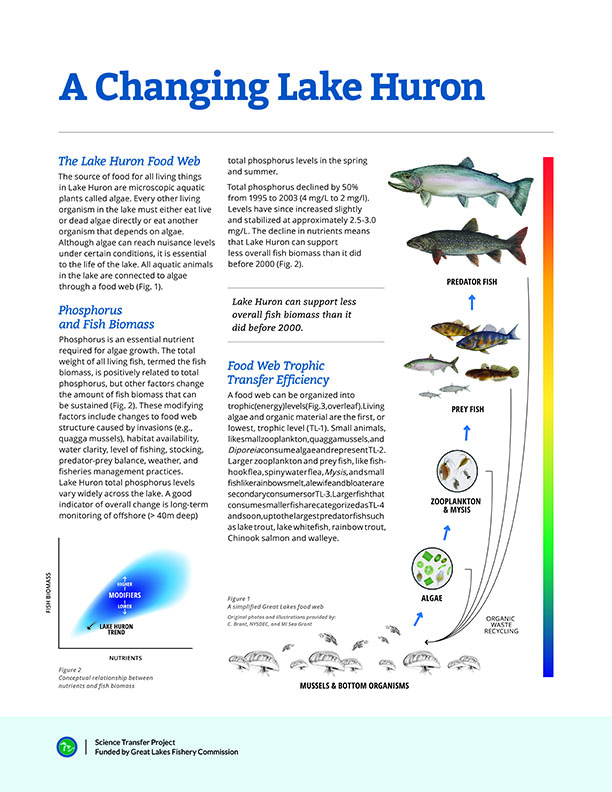Clearer Water Means Less Fish: Understanding How Lower Trophic Level Changes Impact Lake Huron's Fisheries
Anyone that lives, works, or recreates on Lake Huron could tell you about some of the major changes they have observed on the lake over the past decade or two. Where there was once a robust Pacific salmon fishery, anglers are now hard-pressed in most areas to land a coho or Chinook.
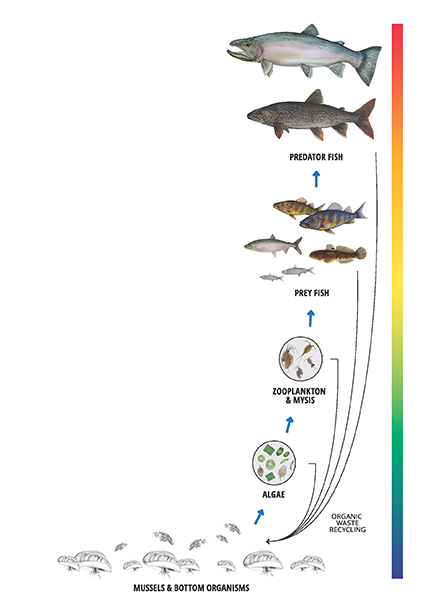
Figure 1. A simplified Great Lakes food web.
All aquatic animals in the lake are connected to each other through a food web (Figure 1). To effectively manage for sustainable fisheries, resource managers must not only understand the food web structure at any given time, but also anticipate possible factors that may impact the food web. For example, what did you eat today for lunch? An apple? A sticky bun? A sandwich? A burger? Food supplies nutrients to our bodies - some healthier than others - that are necessary for survival. Similarly, the Lake Huron ecosystem requires key nutrient inputs (mainly phosphorus) to support the food web structure. Understanding changes to the food web, particularly at the lower levels, is critical to help fishery managers make decisions and implement management actions that address the needs of today and plan for sustainable fisheries in the future.
Changes in Nutrient Status and Energy Flow Through Lower Trophic Levels
Great Lakes fishery resource managers asked the Great Lakes Fishery Commission’s Science Transfer Program to undertake a project to help them better understand and communicate the relationships among changes in lower trophic levels (LTLs), fish communities, and fisheries in Lake Huron. The Science Transfer Program, part of the commission’s Science Program, engages fishery managers, sea lamprey control agents, researchers, and stakeholders to address high-priority management questions. To this end, the Science Transfer Program convened a project team—led by Dr. Tom Stewart, a recently retired fishery biologist with the Ontario Ministry of Natural Resources and Forestry—comprised of technical experts familiar with the Great Lakes ecosystem and food webs. The team was tasked with determining how nutrient changes have impacted LTLs in Lake Huron, and how changes in LTLs may impact the overall structure of the food web.
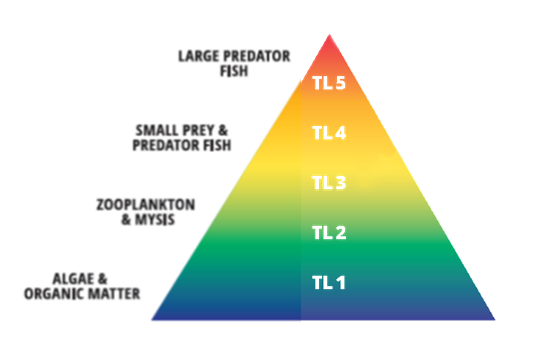
Figure 2. A trophic pyramid.
A food web can be organized into trophic (energy) levels. Trophic levels indicate where different types of organisms fall within the grand scheme of an ecosystem’s food web (Figure 2). Living algae (primary producers) and organic material are the first, or lowest, trophic level (TL-1). Small animals, like microscopic zooplankton, quagga mussels, and Diporeia, consume algae and represent TL-2 (primary consumers). Larger zooplankton, like fishhook water fleas, spiny water fleas, and Mysis as well as small prey fish, like rainbow smelt, alewife, and bloater, make up TL-3 (secondary consumers). Larger fish that consume smaller fish, such as lake trout, Chinook salmon, and walleye, comprise higher trophic levels. The term LTLs in fishery management specifically refers to the plants and small animals at the bottom of a food web, in TL-1 and TL-2, that sustain all other living organisms, such as prey and predator fish. Without LTLs, the rest of a food web cannot exist.
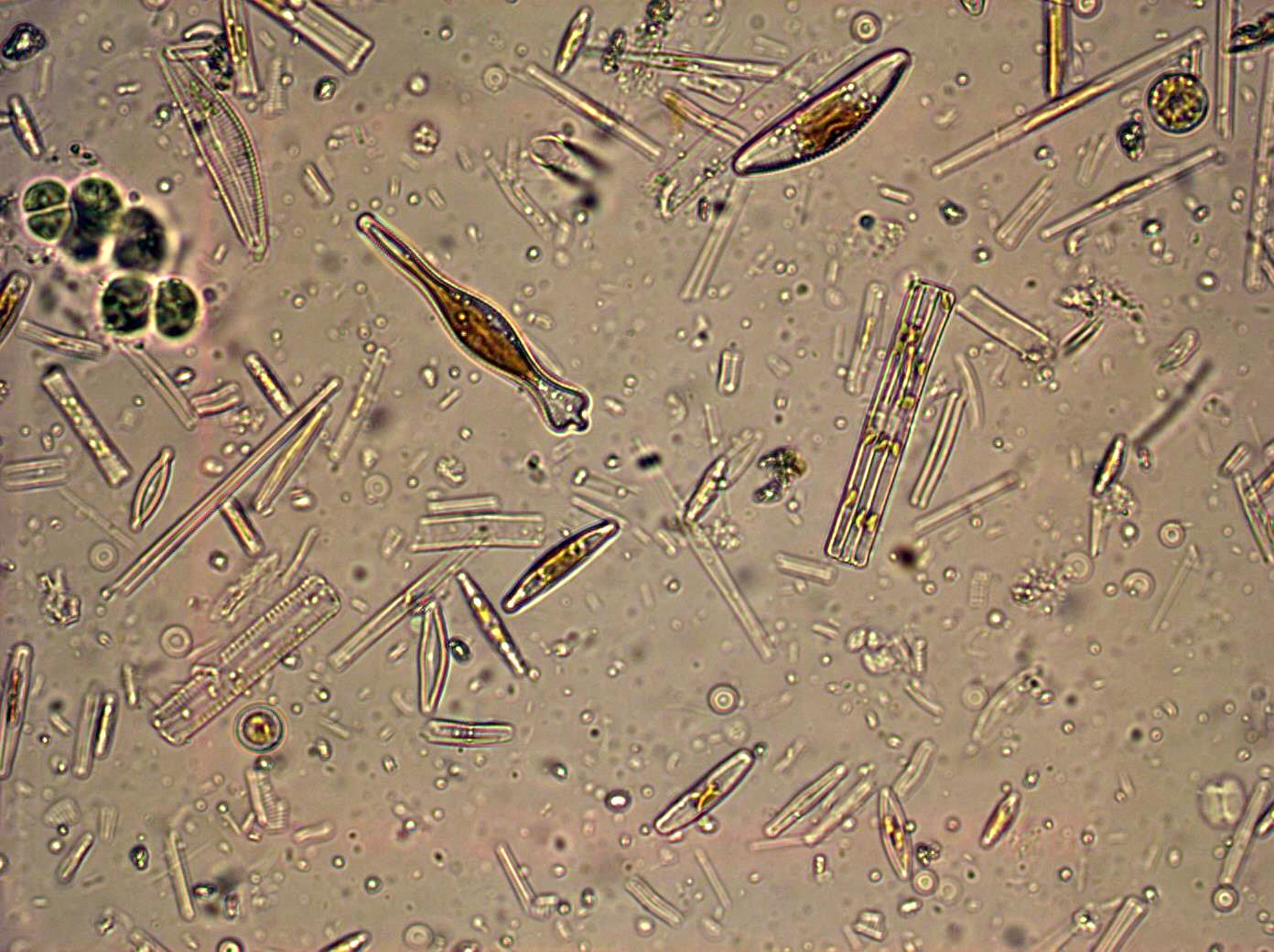
Figure 3. Great Lakes phytoplankton.
Photo credit: Seth Benson, USGS
The most fundamental of these LTL elements is algae (Figure 3), a microscopic aquatic plant capable of making its own food resources from the sun’s energy. Algae is the source of food, directly or indirectly, for all aquatic animals in the Great Lakes. Although it can reach nuisance levels under certain conditions, algae is essential to the life of the lakes. Similarly, an essential requirement for algal growth is the nutrient phosphorus. Phosphorus plays a major role in influencing the food web, and therefore fish biomass (total weight of all fish), but the nutrient is not the only component to be considered. A variety of other factors also affect the food web and the relationship between phosphorus and total fish biomass. All of these pieces must be understood for fishery resource managers to make informed management decisions.
Conceptual Model to Predict and Communicate Influences on Fish Biomass
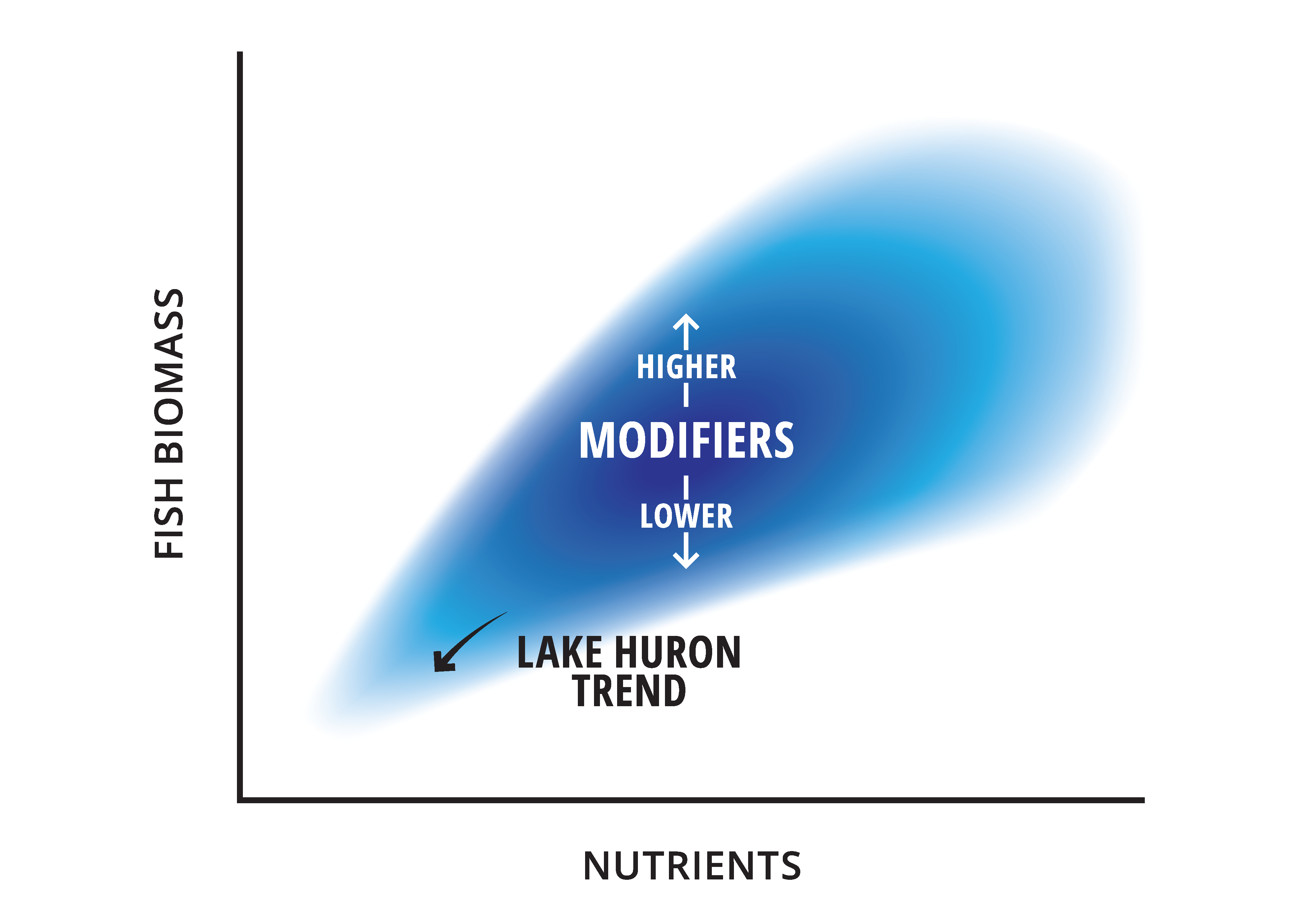
Figure 4. Conceptual relationship between nutrients and total fish biomass. Variation in this relationship increases as nutrient levels increase, as shown by the widening shaded area. This variation is also influenced by modifiers, including fishery management activities, water clarity, and food web structure.
Dr. Stewart’s team developed a conceptual model that indicates a strong positive relationship between total fish biomass and total phosphorus concentration, due to the positive correlation both have to algae (Figure 4). However, this relationship is not simple. Rather, it can vary greatly because of a variety of factors, termed modifiers, that also influence the total fish biomass. These modifiers include fishery management activities like stocking, fishery regulation, habitat protection, and habitat rehabilitation, as well as food web structure, water clarity, and even the weather. As you may have concluded, simple explanations for significant fishery-related events are not typical. For example, there is no single culprit in the alewife collapse. While predation and other factors played a major role, total phosphorus declined by 50% from 1995 to 2003 in Lake Huron. This dramatic decline led to food limitations that also contributed to the collapse. Additionally, those lower phosphorus levels in Lake Huron mean it can now support less overall fish biomass, alewife or otherwise, than it did before 1995.
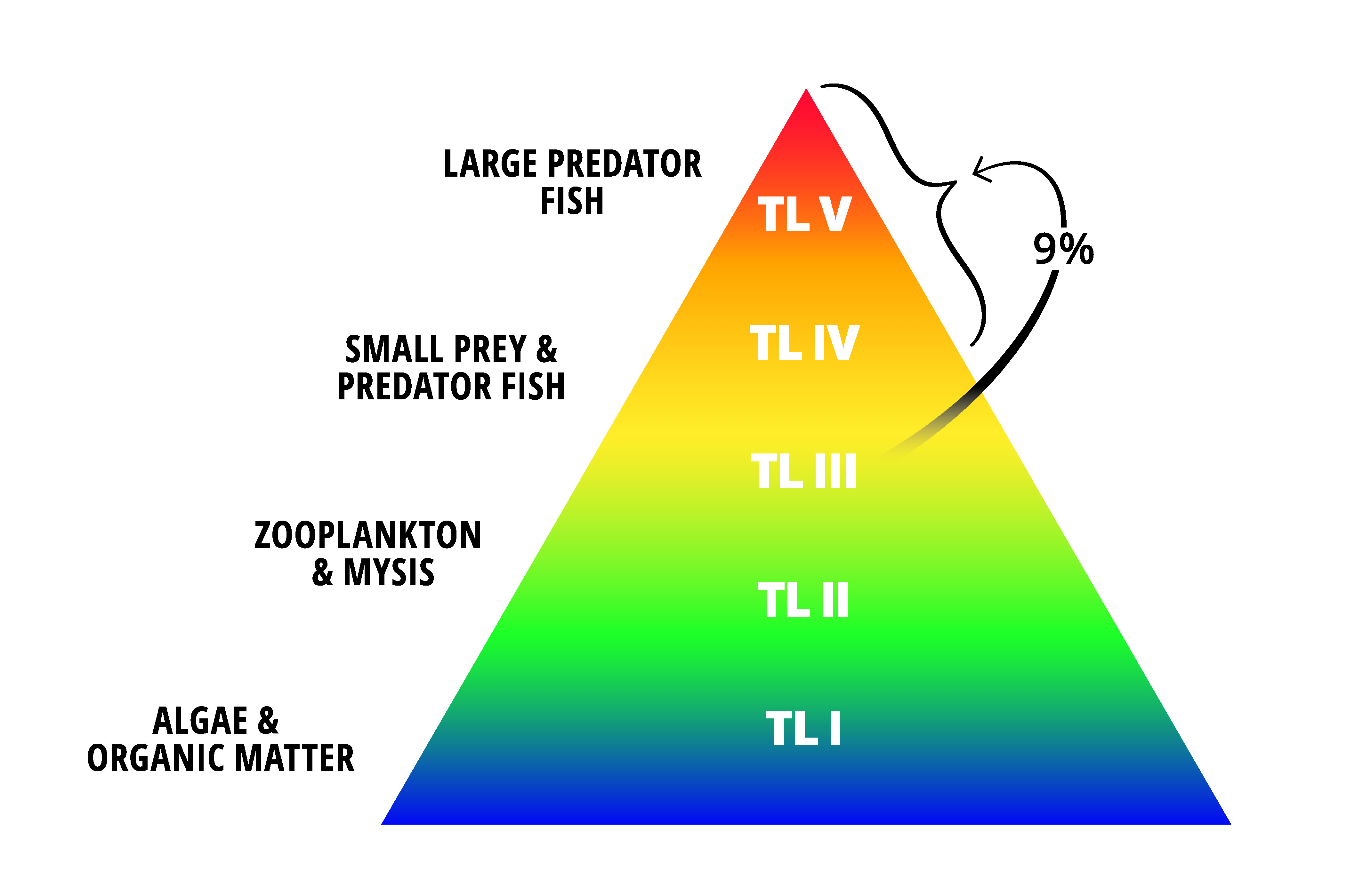
Figure 5. Conceptual model of the influence of TTE on the total fish biomass-nutrient relationship.
In a given lake, food web structure itself acts as a modifier because it affects how efficiently, and among what species, energy and material are transferred from lower trophic levels up through the rest of the food web. Researchers can measure this efficiency, which is termed trophic transfer efficiency (TTE), and use it to determine whether a given food web is functioning efficiently—much like how the measurement of “miles per gallon” tells us how fuel efficient a vehicle is. If the TTE is low, it means that LTL food resources, like algae, are not being efficiently transferred to higher tropic levels. Instead, those nutrients are getting lost along the way and the food web is not performing to its potential. The percent of trophic level production and the TTE used by the project team were estimated based on Lake Huron Ecopath models.
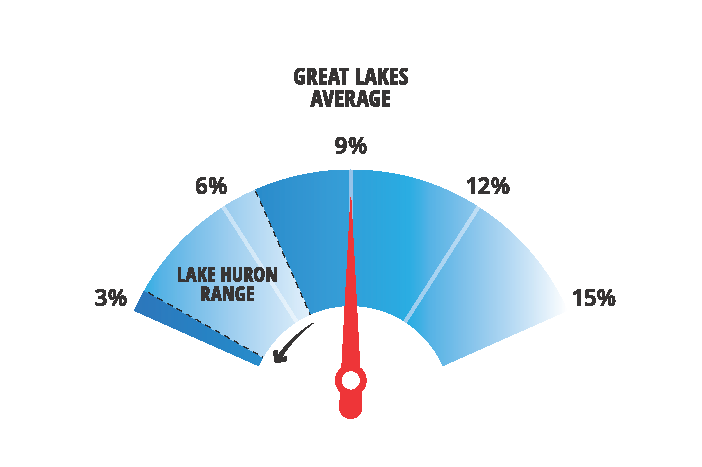
Figure 6. Lake Huron (LH) transfer efficiency compared to Great Lakes average.
Even with plenty of nutrients in a system, total fish biomass cannot reach its potential if the food web is not functioning correctly and energy is not being efficiently transferred between trophic levels (Figure 5). Scientists estimate that on average about 9% of the food energy at TL-3 (small fish, large zooplankton) is transferred to higher tropic levels (TL-4 and TL-5; prey and predator fish) in the Great Lakes. However, Lake Huron’s TTE falls around 5%, meaning the food web is producing only about half the number of predator fish as the Great Lakes average at a given level of nutrients (Figure 6). This is one way that food web structure acts as a modifier on the relationship between phosphorus and total fish biomass in Lake Huron.
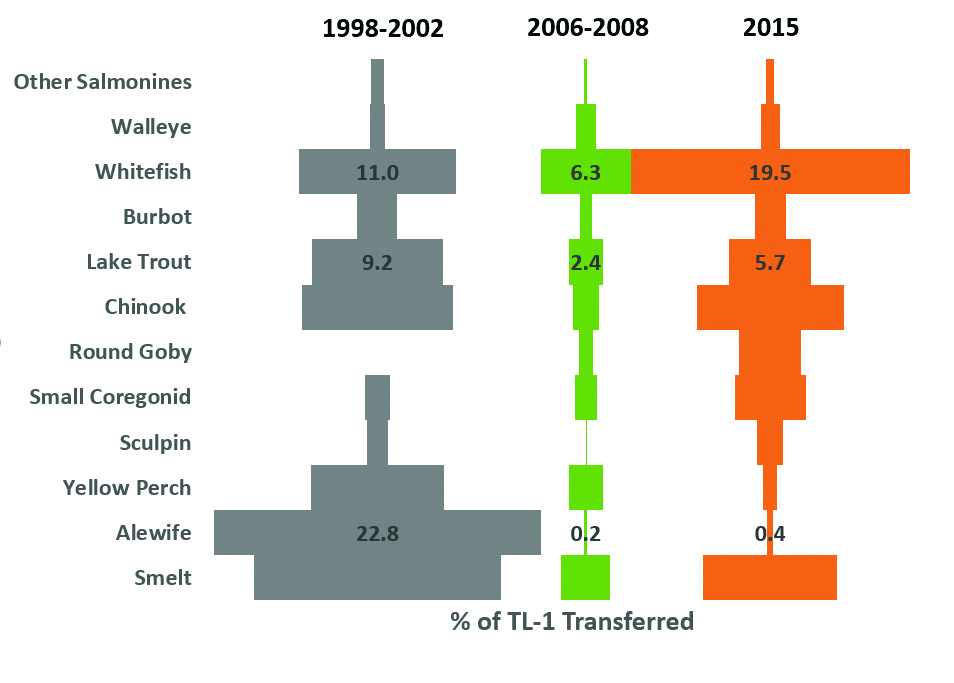
Figure 7. Percent of algal production (TL-1) transferred to Lake Huron fish species. Wide bars represent abundant fish species as a result of efficient transfer of algal production. Narrow bars indicate less algal production transferred and therefore lower prey and predator fish abundance. The narrow bars seen from 2006-2008 follow the Lake Huron alewife collapse as well as other food web changes.
Looking specifically at data from Lake Huron, between 1988-2002, the food web supported abundant prey fish species such as smelt, alewife, yellow perch, and sculpin. This abundant biomass of prey fish effectively ‘channeled’ a higher percentage of algae production (TL-1) to predator fish, therefore increasing predator fish abundance as well (Figure 7; gray bars). During 2006-2008, after the collapse of alewife in 2003 and other food web changes, less algal production was transferred to predator and prey fish species (Figure 7, green bars). For example, just before the collapse of alewife (1998-2002), lake trout populations in Lake Huron received 9.2% of TL-1 production, but after the collapse of alewife, lake trout received only 2.4%. Data from 2015 suggest improvements in overall trophic transfer efficiency (increases in bar width) with increases to lake trout (5.7%) and lake whitefish (19.5%) specifically.
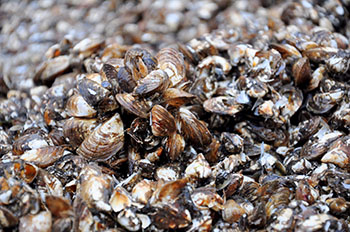
Figure 8. Figure 8. Invasive dreissenid mussels. Photo credit: Andrea Miehls, GLFC.
Water clarity is another modifier. Pollution controls and mussel invasions have resulted in much clearer water across the Great Lakes. This high water clarity has far-reaching effects as it not only impacts LTLs, but fish communities, fisheries, and fishery assessments by affecting fish catchability in commercial and recreational fisheries, fish vulnerability to predation, the distribution of fish, and fish feeding behavior. Invasive zebra and quagga (dreissenid) mussels (Figure 8) have filtered out many of the nutrients causing light penetration to increase. In deeper water the increased availability of light can increases algae production, while in shallower, nearshore waters the change in water clarity has led to a change in dominant plant species from suspended algae to aquatic plants attached to the bottom. This, in turn, has led to a fish community shift that favors certain species over others, such as sunfish and northern pike over walleye.
Implications for Fishery Management
Are unexpected changes to the fish community always for the worse? Surprisingly no, but it might require a shift in our thinking. Even though changes in fish community structure affect the status quo, having fewer fish or a different composition of species available does not necessarily mean low-valued, unsustainable fisheries. As many Great Lakes ecosystems shift to a decreased nutrient state, not all fish species will be sustained at historical levels. However, as certain species decrease, others may thrive. The challenge is twofold: stakeholders must be willing to adjust their expectations while fishery managers must continue to innovate and adapt management actions to account for these changes.
The Lake Huron ecosystem has changed. Nutrients have declined, water clarity has increased, the food web is disrupted, and populations of some desirable species of fish have declined. However, fishery management activities can still sustain populations and improve fisheries. Important considerations to achieve these goals include:
- Lower abundances of important fish species should be expected due to reduced nutrients and a disrupted food web.
- Rehabilitation of native prey may improve food web function and increase trophic transfer efficiency.
- Non-native mussels have altered food web structure and impede production of some desirable species.
- Nearshore and bay fisheries are responding positively to food web changes.
- Research to better understand how food web changes affect fisheries is needed.
The Lake Huron Committee, with partner agencies, is working to achieve the right balance to maintain water quality, rehabilitate the food web, and develop and sustain fisheries.
Project Team
The project team was composed of Tom Stewart (Retired; Ontario Ministry of Natural Resources and Forestry), Andy Todd (Ontario Ministry of Natural Resources and Forestry), Brian Weidel (United States Geological Survey), David (Bo) Bunnell (United States Geological Survey), Lars Rudstam (Cornell Biological Station), and Julie Hinderer (GLFC).
Read more Pulse on Science: Project Spotlights
- New Study Concludes Invasive Sea Lampreys Can Be Controlled by the Release of Sterilized Males
- Happy 75th anniversary to Hammond Bay Biological Station!
- Great Lakes Habitat Restoration: Partnering to Promote Fish Production
- Sea Lamprey Control Spreads the Distance
- Making the Best of a Bad Situation: Great Lakes Sea Lampreys Reveal the Origins of Vertebrate Traits
- Studying the Fish of Buffalo Reef, Traverse Bay, Lake Superior
- Doing Science is Essential...Communicating Science is Just as Critical (and maybe more FUN!)
- Faithful Fish: Walleye Show High Spawning Site Fidelity in the Great Lakes
- Finding the Sea Lamprey's Kryptonite
- Good Things Come in...Polymer Packages?
- Rambunctious Reproduction Overheard Among Great Lakes' Lake Trout
- Clearer Water Means Less Fish: Understanding How Lower Trophic Level Changes Impact Lake Huron's Fisheries


